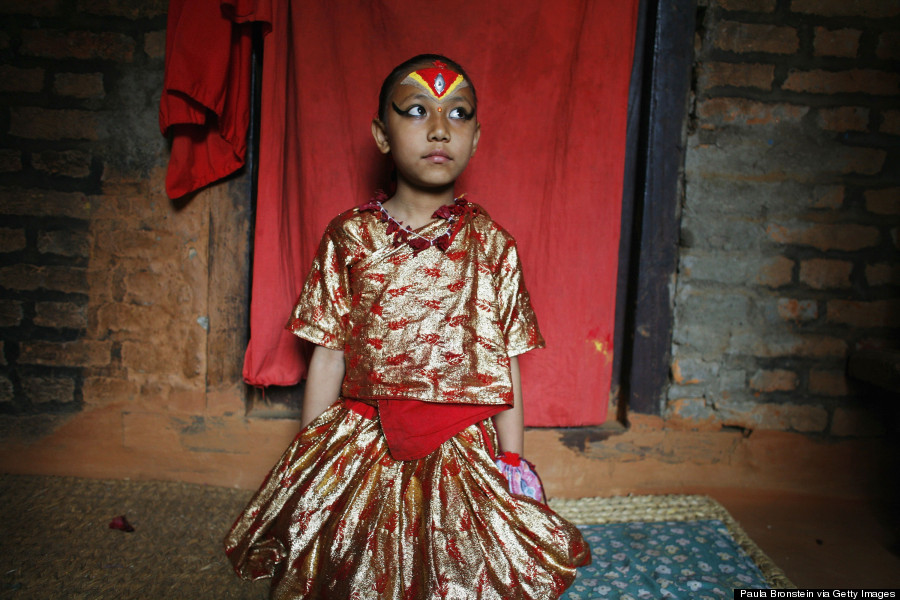Though in some traditions goddesses exist only in the spiritual realm, in Nepal they live and breathe.
These kumari, or "living goddesses," are pre-pubescent girls considered to be the earthly manifestations of divine female energy, incarnations of the goddess known as Taleju, the Nepalese name for Durga.
Selected as children, they live in temples, are carried in chariots during festivals and are worshipped by thousands of Hindus and Buddhists. They retire upon puberty.
Some activists criticize the custom as a form of child labor which hinders the freedom and education of kumaris, particularly as they are confined to houses or temples and bound to strict daily rituals, reports the South China Morning Post. However, in 2008, Nepal's Supreme Court overruled a petition against the practice due to its cultural and religious significance.
Ex-kumari Chanira Bajracharya spoke to the SCMP about the challenges she faced after her retirement, during the difficult transition from goddess to mortal. "It was a challenging transition," she said. "[After retirement] I couldn't even walk properly because I had been carried all the time. The outside world was a complete stranger to me."
The Royal Kumari is the most respected, though more are chosen from different clans. The Royal Kumari's feet never touch the ground during her tenure -- whenever she leaves the palace, she is carried in a golden palanquin. Kumari are always dressed in red, and have a symbolic "fire eye" painted on their foreheads.
Look into the lives of the living goddesses here:

Nepal's living goddess locally known as Kumari, Samita Bajracharya, watches the last day of Rato Machhendranath chariot festival in Patan, outskirts of Katmandu, Nepal, Sunday, June 24, 2012. Kumari, meaning virgin in Nepalese, are young pre-pubescent girls and are considered by devotees to be incarnations of a Hindu goddess. Selected as toddlers, living goddesses usually keep their positions until they reach puberty. (AP Photo/Binod Joshi)

Caretakers and devotees of the Kumari, or living Goddess, carry her on a palanquin to the Ghode Jatra festival, an annual horse-racing festival, in Katmandu, Nepal, Wednesday, March, 22, 2012. According to legend, the festival is held to celebrate the victory over a demon named Tundi who lived in the area known as Tundikhel and is believed that the clamor of horses' hooves on Ghode Jatra keeps the demon's sprit away. (AP Photo/Binod Joshi)

A Kumari, or living Goddess, sits on a palanquin carried by devotees towards the Ghode Jatra festival, an annual horse-racing festival, in Katmandu, Nepal, Wednesday, March, 22, 2012. According to legend, the festival is held to celebrate the victory over a demon named Tundi who lived in the area known as Tundikhel and is believed that the clamor of horses' hooves on Ghode Jatra keeps the demon's sprit away. (AP Photo/Binod Joshi)

Nepal's living goddesses locally known as Kumari looks on during the annual cleaning ritual of deity Seto Machhendranath or god of rain in Katmandu, Nepal, Sunday, Jan. 1, 2012. Living goddesses are worshipped by both Hindus and Buddhists. Selected as toddlers, they usually keep their positions until they reach puberty. (AP Photo/Niranjan Shrestha)

Devotees carry Nepal's living goddess, locally known as Kumari, for a chariot procession during Indra Jatra festival, in Katmandu, Nepal, Sunday, Sept.11, 2011. Indra Jatra marking the end of the monsoon season is celebrated to worship God of rain Indra. (AP Photo/Binod Joshi)

Nepal's new Kumari (Living Goddess) Shreeya Bajracharya, 6, takes her seat to perform rituals at a temple in Bhaktapur on the outskirts of Kathmandu on October 14, 2008. Hindu devotees offer prayers to the living goddess at the temple during the formal conclusion of the 15-day long Hindu festival Dashain (Durga Puja). AFP PHOTO/Prakash MATHEMA (Photo credit should read PRAKASH MATHEMA/AFP/Getty Images)

Matani Shakya, 3, newly appointed "kumari," or living goddess in Nepal, is greeted by a crowd as she is taken to kumari house in Katmandu, Nepal, Tuesday, Oct. 7, 2008. Selected between the ages of 2 and 4, living goddesses are worshipped by both Hindus and Buddhists. Devotees touch the girls' feet with their foreheads, the highest sign of respect among Hindus in Nepal. During religious festivals the girls are wheeled around on a chariot pulled by devotees. (AP Photo/Binod Joshi)

BHAKTAPUR, NEPAL - MARCH 24: Kumari Devi (Royal Living Goddess) Sajani Shakya, 9, gets ready for puja, on March 24, 2007 in Bhaktapur, Nepal. As a royal Kumari, Sajani has a very different life from the other two royal Kumari's, the rules in Bhaktapur differ and she is allowed to attend school and experiences a fairly normal life. Nepal has countless gods, goddesses, deities and Buddhas. The Kumari Devi is a young girl who is prepubescent, considered to be a real goddess, worshipped and revered, the practice going back hundreds of years into Nepali culture. She must meet 32 strict physical requirements ranging from the color of her eyes to the sound of her voice. Her horoscope must also be appropriate as well. Although there are many Kumaris in Nepal, the Kathmandu goddess is the most important and only makes rare public appearances. The Kumari's reign ends with her first period, after that she reverts back to the status of a normal mortal. (Photo by Paula Bronstein/Getty Images)

BHAKTAPUR, NEPAL - MARCH 24: Kumari Devi (Royal Living Goddess) Sajani Shakya, 9, sits on the special throne for puja used for blessings and religious ceremony, on March 24, 2007 in Bhaktapur, Nepal. As a royal Kumari, Sajani has a very different life from the other two royal Kumari's, the rules in Bhaktapur differ and she is allowed to attend school and experiences a fairly normal life. Nepal has countless gods, goddesses, deities and Buddhas. The Kumari Devi is a young girl who is prepubescent, considered to be a real goddess, worshipped and revered, the practice going back hundreds of years into Nepali culture. She must meet 32 strict physical requirements ranging from the color of her eyes to the sound of her voice. Her horoscope must also be appropriate as well. Although there are many Kumaris in Nepal, the Kathmandu goddess is the most important and only makes rare public appearances. The Kumari's reign ends with her first period, after that she reverts back to the status of a normal mortal. (Photo by Paula Bronstein/Getty Images)

PATAN, NEPAL - MARCH 23: Kumari Devi (means Royal Living Goddess) Chanira Bajracharya, 12, sits in the puja room waiting for people to come and bless her March 23, 2007 in Patan, Nepal. As a royal Kumari, Chanira doesn't leave the home except for special holidays, and is tutored since she isn't allowed go to a public school. Nepal has countless gods, goddesses, deities and Buddhas. The Kumari Devi is a young girl who is prepubescent, considered to be a real goddess, worshipped and revered, the practice going back hundreds of years into Nepali culture. She must meet 32 strict physical requirements ranging from the color of her eyes to the sound of her voice. Her horoscope must also be appropriate as well. Although there are many Kumaris in Nepal, the Kathmandu goddess is the most important and only makes rare public appearances. The Kumari's reign ends with her first period, after that she reverts back to the status of a normal mortal. (Photo by Paula Bronstein/Getty Images)

Kumari, Nepal's Living Goddess, is carried outside her palace during the Dasain festival in Katmandu, Nepal, Saturday, Sept. 30, 2006. Nepal's supreme court has ordered the government to investigate possible children's rights violations in a local tradition of worshipping a virgin girl as a living goddess, an official said on Thursday, Nov. 2, 2006. The Living Goddess, worshipped by both Hindus and Buddhists, is selected from a group of small girls, usually aged 3 or 4, who have gone through several tests, including spending a night among the heads of ritually slaughtered goats and buffaloes. (AP Photo/Binod Joshi)
